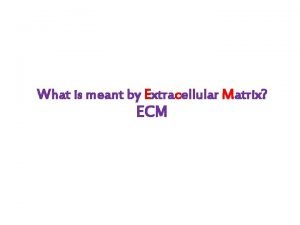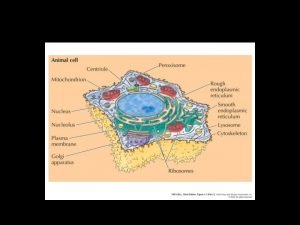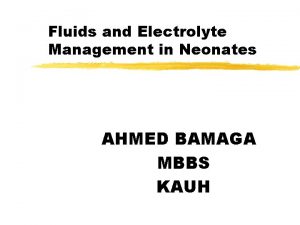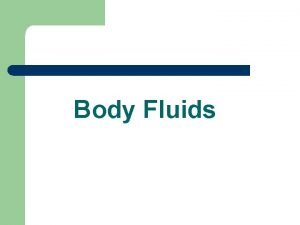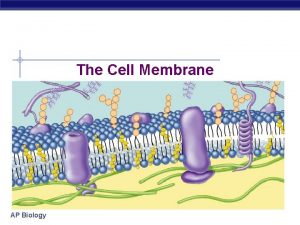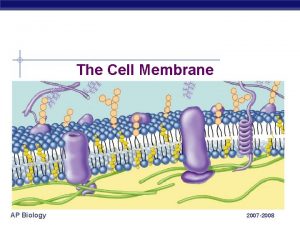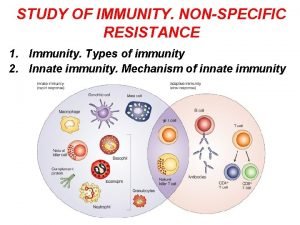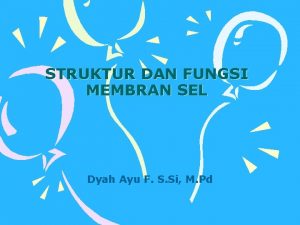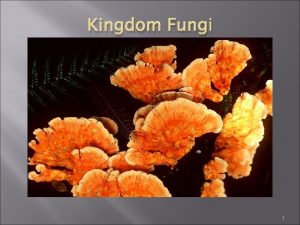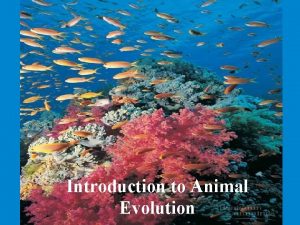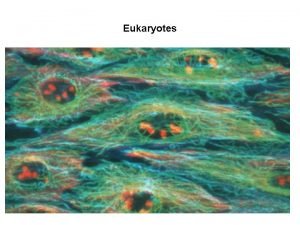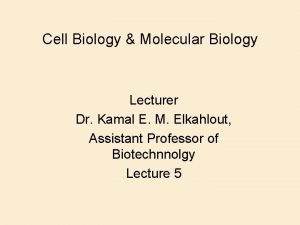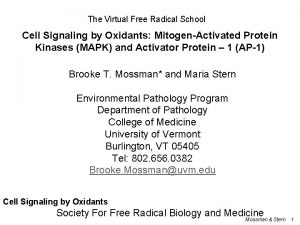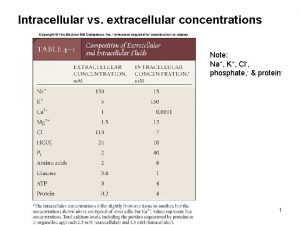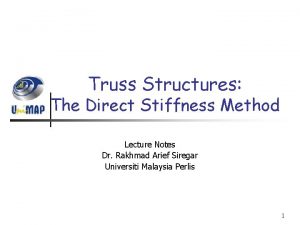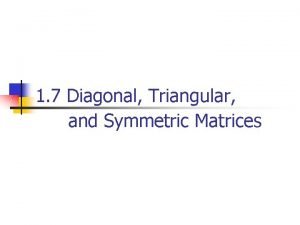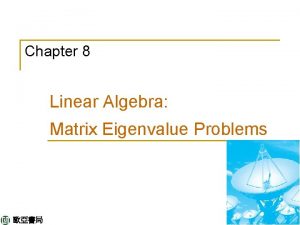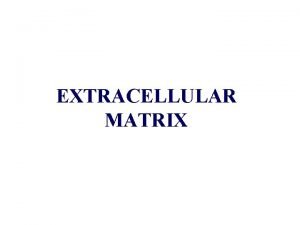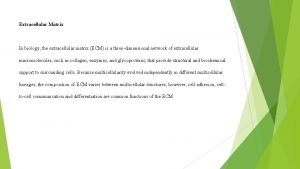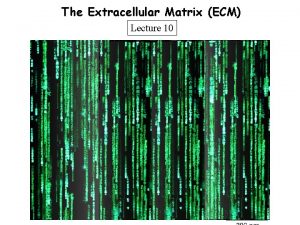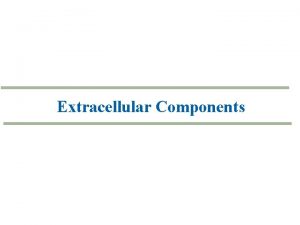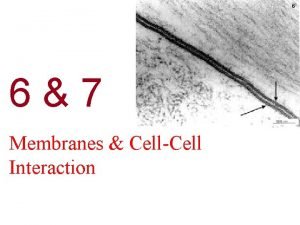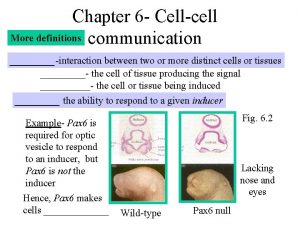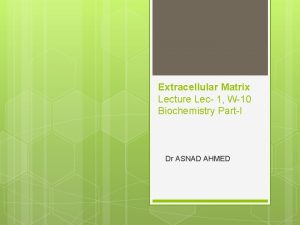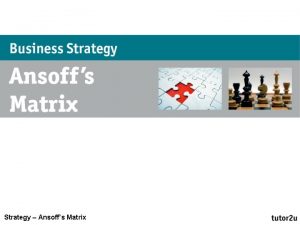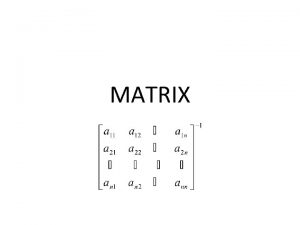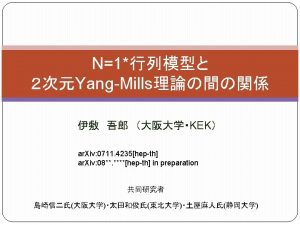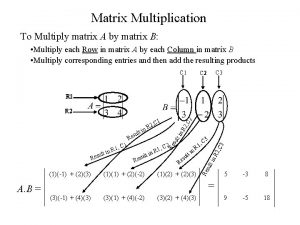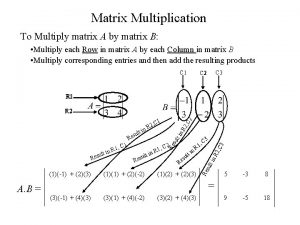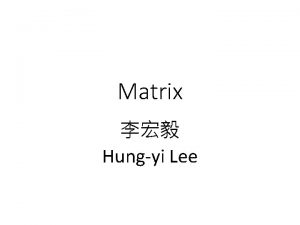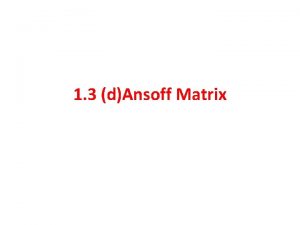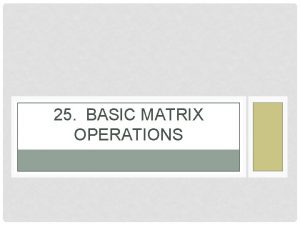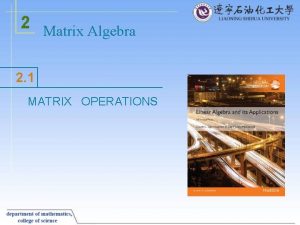Lecture 8 the extracellular matrix and cellcell interaction

















































- Slides: 49


Lecture 8: the extracellular matrix and cell-cell interaction Dr. Mamoun Ahram Faculty of Medicine Second year, Second semester, 2014 -2014 Principles of Genetics and Molecular Biology

The extracellular matrix

What is it? The extracellular matrix fills the spaces between cells and binds cells and tissues together. Types: Basal laminae: thin, sheetlike, structure upon which layers of epithelial cells rest it supporting sheets of epithelial cells It surrounds muscle cells, adipose cells, and peripheral nerves. Connective tissues Loose network of proteins and carbohydrates underneath epithelial cell layers where fibroblasts are distributed. Others: bone, tendon, and cartilage.

Matrix structural proteins Tough fibrous proteins embedded in a gel-like polysaccharide ground substance. Adhesion proteins that link components of the matrix both to one another and to attached cells. The of basal laminae is formed of matrix components that differ from those found in connective tissues. Tendons contain a high proportion of fibrous proteins Cartilage contains a high concentration of polysaccharides that form a firm compression-resistant gel. In bone, the extracellular matrix is hardened by deposition of calcium phosphate crystals.


The collagens The most abundant proteins in mammals (25% of the total protein mass). Long, stiff, triple-stranded helical structure made of three α chains A basic unit of mature collagen is called tropocollagen. Rich in glycine (33%), proline (13%), and hydroxyproline (9%) Sequence is (pro-Gly-X) or (hydroxypro-Gly-X) Contains hydroxylysine (attachment of polysaccharides) Crosslinking of chains via lysine and aldolysine via the action of lysyl oxidase

Types of collagens 30 collagen genes that form >20 different types of collagen that resist tissue stretching. Types: Fibrillar collagens Fibril-associated collagens Network-forming collagens Anchoring fibrils Transmembrane collagens

Types of fibrillar collagens Type I: most connective tissues (Long, aligned in parallel to each other, and rigid (fit to be in bone structure) Type II: cartilage and vitreous humor smaller in diameter than type I and oriented randomly in the viscous proteoglycan matrix rigid macromolecules, but compressible (to resist large deformations in shape and absorb shocks) Type III: extensible tissues (skin and lung) Type XI: cartilage Type XXIV: bone and cornea Type XXVII: eye, ear, and lung

Assembly of fibrillar collagens After secretion, they assemble into collagen fibrils (thin structures visible in electron micrographs). Collagen fibrils aggregate into collagen fibers (larger, cable-like bundles seen in the light microscope)

Others Fibril-associated collagens Collagen types IX and XII: link fibrils to one another and to other components in the ECM. Network-forming collagens Types IV: constituent of the basal laminae. Anchoring fibrils Associate network-forming collagens to fibrillar collagens

Synthesis of collagen Individual collagen polypeptide chains are synthesized into the endoplasmic reticulum (ER) as pro- chains. In the ER, selected prolines and lysines are hydroxylated and some of the hydroxylysines are glycosylated. One chain combines with two others forming procollagen. During or following exocytosis, extracellular enzymes, the procollagen peptidases, remove the N-terminal and C-terminal propeptides forming tropocollagen (or simply collagen). Excision of both propeptides allows the collagen molecules to polymerize into normal fibrils in the extracellular space.


Fibrillar vs. network-forming collagens The structure of network-forming collagens is interrupted by one or two short nonhelical domains, which makes the molecules more flexible than fibrillar collagen molecules. Network-forming collagens are not cleaved after secretion and therefore retain their propeptides Network-forming collagens do not aggregate with one another to form fibrils in the extracellular space.

Premature cleavage The potentially catastrophic assembly of fibrils within the cell does not occur because: The propeptides inhibit fibril formation. Lysyl oxidase, which catalyzes formation of reactive aldehydes, is an extracellular enzyme.

Collagen-related diseases Collagen is highly crosslinked in tissues where tensile strength is required such as Achilles tendon If crosslinking is inhibited, the tensile strength of fibers is greatly reduced, collagenous tissues become fragile, and structures tend to tear (skin, tendon, and blood vessels)

Scurvy Deficiency of vitamin C results in insufficient formation of hydroxyproline and, hence, poor synthesis of collagen, formation of unstable triple helices. Nonhydroxylated procollagen chains are then degraded within the cell. Symptoms: skin and gum lesions and weak blood vessels

Osteogenesis imperfecta (Brittle-bone disease) “Osteogenesis imperfecta" = imperfect bone formation A genetic disorder of several forms that cause fragile, soft, brittle, and easily broken bones. Four types of osteogenesis imperfecta designated as type I through type IV Type I: the mildest form of the condition Type II: the most severe form that results in death in utero or shortly after birth Milder forms generate a severe crippling disease

Mutations of OI Mutations in the COL 1 A 1 and COL 1 A 2 genes that interfere with the assembly of type I collagen. Defective collagen weakens connective tissues, particularly bone, resulting in the characteristic features of OI OI types I, II, and IV have an autosomal dominant pattern of inheritance One copy of the altered gene is sufficient to cause the condition

Chondrodysplasias Mutations affecting type II collagen cause chondrodysplasias, characterized by abnormal cartilage, which leads to bone and joint deformities.

Ehlers-Danlos syndrome A heterogeneous group of disorders that affect the skin, bones, blood vessels, and other organs. The signs and symptoms vary from mild to life-threatening. All result from defects in collagen synthesis and/or processing. Mutations in type I, III, or V collagen or in the synthesis of collagen processing enzymes like procollagen Npeptidase, or lysyl hydroxylase Major manifestations are skin fragility and hyperextensibility and joint hypermobility.

Type III EDS The most clinically important mutations are found in the gene of type III collagen. Since type III collagen is a major component of arteries, mutations affecting type III collagen result in fragile blood vessels. Other symptoms include stretchy skin and hypermobile joints.

Elastin The main component of elastic fibers is elastin Highly hydrophobic Rich in proline and glycine. Contains some hydroxyproline, but no hydroxylysine Not glycosylated

Formation of elastic network Secretion of tropoelastin Assembly into elastic fibers Crosslinking via lysines

Elastin structure The elastin protein is composed largely of two types of short segments that alternate along the polypeptide chain: hydrophobic segments, which are responsible for the elastic properties of the molecule; and alanine- and lysine-rich a-helical segments, which form cross-links between adjacent molecules

Function of elastic fiber Elastin is the dominant extracellular matrix protein in arteries. The normal elasticity of an artery restrains the proliferation of these cells. Abnormal or deficiency of the elastin results in excessive proliferation of smooth muscle cells in the arterial wall and narrowing of the aorta.

Microfibrils The elastin core is covered with a sheath of microfibrils (composed of a number of distinct glycoproteins, including the large glycoprotein fibrillin, which binds to elastin and is essential for the integrity of elastic fibers). Marfan's syndrome: mutated fibrillin, rupture of aorta.

Marfan's syndrome Due to mutated fibrillin Rupture of aorta. Others: A tall, thin build; Long arms, legs, fingers, and toes and flexible joints; Scoliosis, or curvature of the spine; A chest that sinks in or sticks out; Crowded teeth; Flat feet.

Emphysema (destructive lung disease) Due to a dysfunctional alpha-1 antitrypsin deficiency leading to increased activity of elastase in lungs The lysine to-glutamate mutation causes protein misfolding, formation of an aggregate and block of ER export. Cigarette smoking also inactivates alpha 1 -antitrypsin by oxidizing essential methionine residues, decreasing the enzyme activity by a factor of 2000.

Matrix polysaccharides Glycosaminoglycans (GAGs): Polysaccharides of repeated disaccarides One is either N-acetylglucosamine or Nacetylgalactosamine The other is usually acidic (either glucuronic acid or iduronic acid) highly negatively charged Modified by a sulfate groups. Exist as proteoglycans Some are cell surface proteins with either transmembrane domains (syndecans) or GPI anchors (glycipans) interacting with integrins. Hyaluronan: no sulfate, not a proteoglycan

Perlecan Proteoglycans bind to matrix proteins forming gellike networks Example: perlecan Heparan sulfatee proteoglycan + collagen and laminin in basal laminae

Aggregan A large proteoglycan consisting of more than 100 chondroitin sulfate chains joined to a core protein. Multiple aggrecan molecules bind to long chains of hyaluronan that become trapped in the collagen network, forming large complexes in the ECM of cartilage.

Matrix adhesion proteins They link matrix proteins with one another and to the surfaces of cells. Fibronectin: the principal adhesion protein of connective tissues. A dimeric glycoprotein that is crosslinked into fibrils by disulfide bonds. Binds to collagen and GAGs Binds to cell surface proteins like integrins linking cells to the ECM

Laminin Found in basal laminae T-shaped heterodimers with binding sites for cell surface receptors, type IV collagen, and perlecan. laminins are tightly associated with another adhesion protein, called nidogen, which also binds to type IV collagen, all of which form crosslinked networks in the basal lamina.

Cell-matrix interactions Role of integrins are a family of transmembrane heterodimers (α and β) They bind to short sequences present in ECM proteins. They also anchor the cytoskeleton at focal adhesions and hemidesmosomes.

Development of focal adhesion 1. Activation of integrin and binding to ECM 2. Recruitment of additional integrins forming focal complex 3. Development of focal adhesion

Cell-cell interaction

Cell Adhesion Molecules Family Selectins Ligands recognized Carbohydrates Extracellular matrix Integrins Stable cell junctions No Focal adhesions and hemidesmosomes Members of Ig No superfamily Ig superfamily Integrins No Homophilic interactions No Adherens junctions Cadherins Homophilic interactions and desmosomes

Role of Selectins in leukocyteendothelial cell interaction

Homophilic vs. heterophilic interaction

Cadherins Selective adhesion between embryonic cells and formation of stable junctions between cells in tissues. Classic cadherins E-cadherin: epithelial cells N-cadherin: neural cells P-cadherin: placental cells Desmosomal cadherins 7 -Transmembrane cadherins

Adherens junctions

Desmosomes Desmosomal cadherins heterophilic interaction

Tight junctions They are usually associated with adherens junctions and desmosomes in a junctional complex Functions: Separation of the two sides of cells Example: lumen of the intestine from the underlying connective tissue Block free passage of molecules (including ions) between the cells of epithelial sheets. Separation of the apical and basolateral domains.

Molecular composition of tight junctions a network of protein strands that continues around the entire circumference of the cell Each strand in these networks is composed of transmembrane proteins (claudins, occludin, and JAMs) that bind to similar proteins on adjacent cells, thereby sealing the space between their plasma membranes

Tight junction proteins The three proteins interact with similar proteins on adjacent cells. They also interact with the actin cytoskeleton via zonula occludens protein.

Gap junctions They provide direct connections between the cytoplasms of adjacent cells as open channels allowing ions and small molecules including signaling molecules to diffuse freely between neighboring cells, but preventing the passage of proteins and nucleic acids.

Molecular composition of gap junctions They are made of transmembrane proteins called connexins where six of them assemble to form a connexon (a cylinder with an open aqueous pore in its center). Specilaized connexon = electrical synapse

Gap junction diseases Charcot-Marie-Toth disease (degeneration of peripheral myelinated nerves) Deafness: inability to rapidly exchange K+ Cataracts: inability to obtain nutrients from the lens epithelial cells Skin disease
 Connective adipose tissue function
Connective adipose tissue function Extracellular
Extracellular Intracellular and extracellular
Intracellular and extracellular Transcellular fluid
Transcellular fluid Movement of body fluids
Movement of body fluids Major intra and extracellular electrolytes
Major intra and extracellular electrolytes 01:640:244 lecture notes - lecture 15: plat, idah, farad
01:640:244 lecture notes - lecture 15: plat, idah, farad Ecf icf and interstitial fluid
Ecf icf and interstitial fluid Is synovial fluid extracellular fluid
Is synovial fluid extracellular fluid Body fluids
Body fluids Hypoosmotic
Hypoosmotic Extracellular fluid
Extracellular fluid Extracellular fluid composition
Extracellular fluid composition Non specific innate immunity
Non specific innate immunity Model membran sel
Model membran sel Nature reviews immunology
Nature reviews immunology Extracellular digestion
Extracellular digestion Extracellular digestion
Extracellular digestion Outline two roles of extracellular components
Outline two roles of extracellular components Extracellular signal
Extracellular signal Extracellular signal regulated kinase
Extracellular signal regulated kinase Cl extracellular concentration
Cl extracellular concentration Iatf clauses
Iatf clauses Global stiffness matrix
Global stiffness matrix Diagonal matrix
Diagonal matrix Skew hermitian matrix
Skew hermitian matrix Dissimilarity matrix in data mining
Dissimilarity matrix in data mining P
P Hình ảnh bộ gõ cơ thể búng tay
Hình ảnh bộ gõ cơ thể búng tay Lp html
Lp html Bổ thể
Bổ thể Tỉ lệ cơ thể trẻ em
Tỉ lệ cơ thể trẻ em Gấu đi như thế nào
Gấu đi như thế nào Tư thế worms-breton
Tư thế worms-breton Alleluia hat len nguoi oi
Alleluia hat len nguoi oi Các môn thể thao bắt đầu bằng tiếng nhảy
Các môn thể thao bắt đầu bằng tiếng nhảy Thế nào là hệ số cao nhất
Thế nào là hệ số cao nhất Các châu lục và đại dương trên thế giới
Các châu lục và đại dương trên thế giới Công thức tiính động năng
Công thức tiính động năng Trời xanh đây là của chúng ta thể thơ
Trời xanh đây là của chúng ta thể thơ Mật thư tọa độ 5x5
Mật thư tọa độ 5x5 101012 bằng
101012 bằng độ dài liên kết
độ dài liên kết Các châu lục và đại dương trên thế giới
Các châu lục và đại dương trên thế giới Thể thơ truyền thống
Thể thơ truyền thống Quá trình desamine hóa có thể tạo ra
Quá trình desamine hóa có thể tạo ra Một số thể thơ truyền thống
Một số thể thơ truyền thống Cái miệng bé xinh thế chỉ nói điều hay thôi
Cái miệng bé xinh thế chỉ nói điều hay thôi Vẽ hình chiếu vuông góc của vật thể sau
Vẽ hình chiếu vuông góc của vật thể sau Thế nào là sự mỏi cơ
Thế nào là sự mỏi cơ

